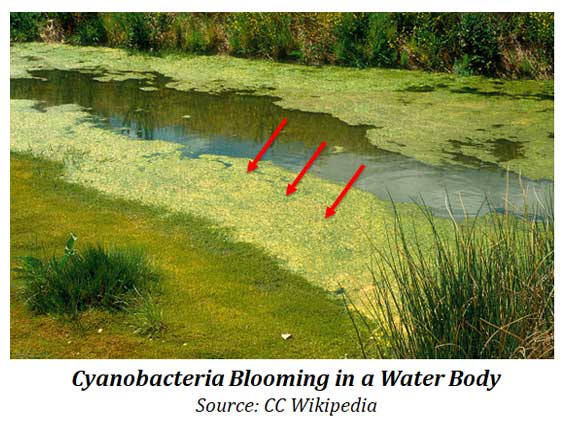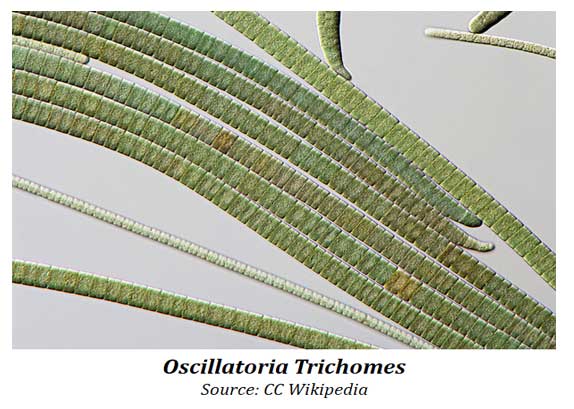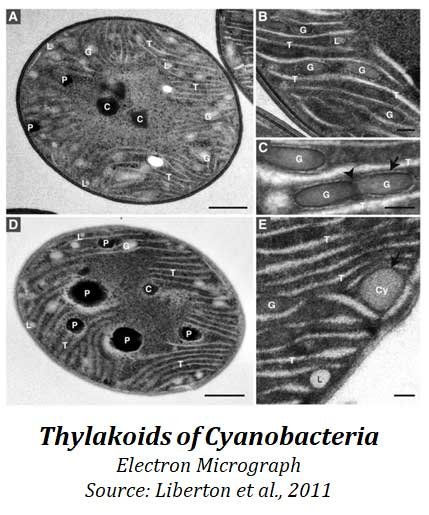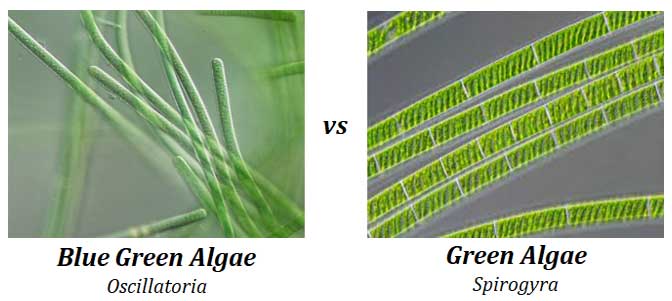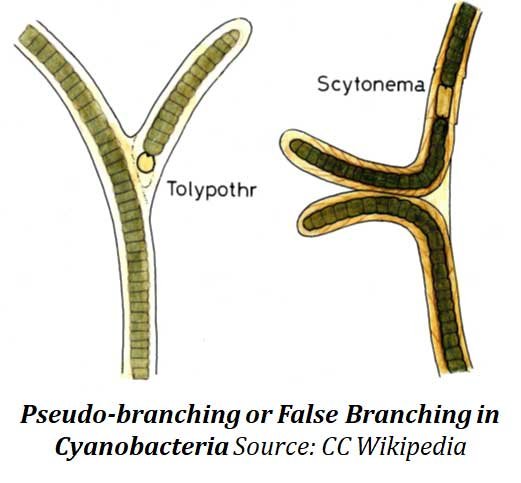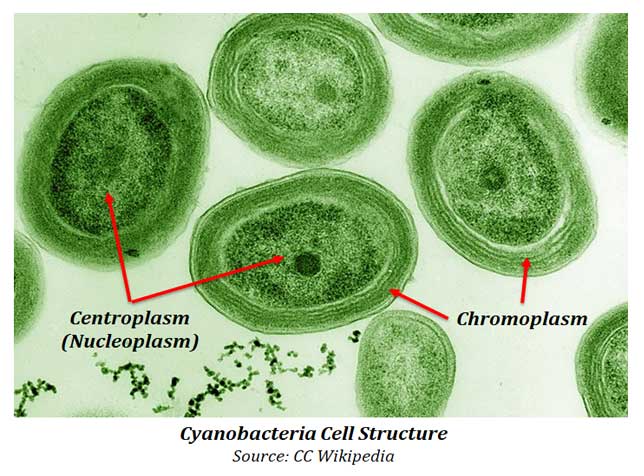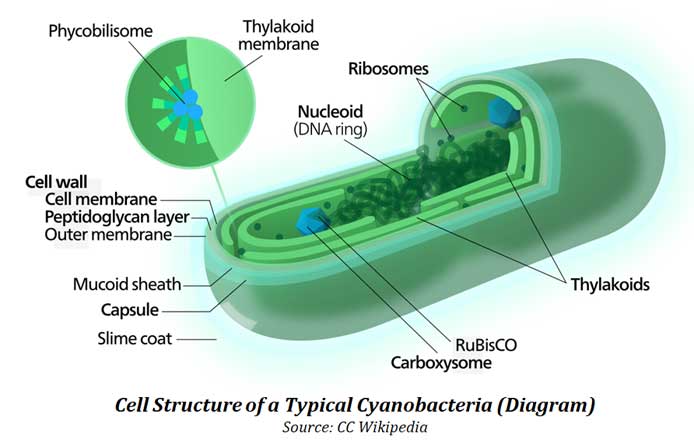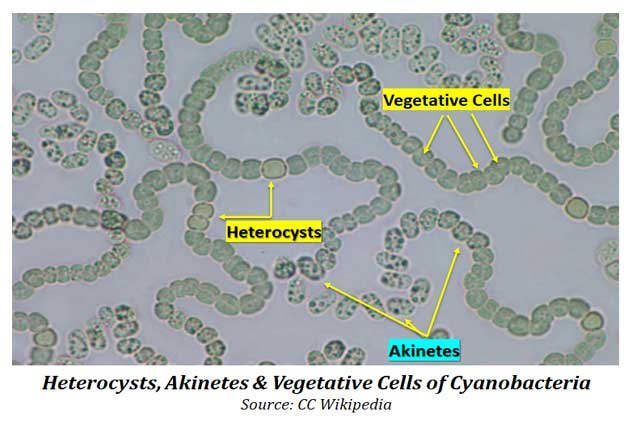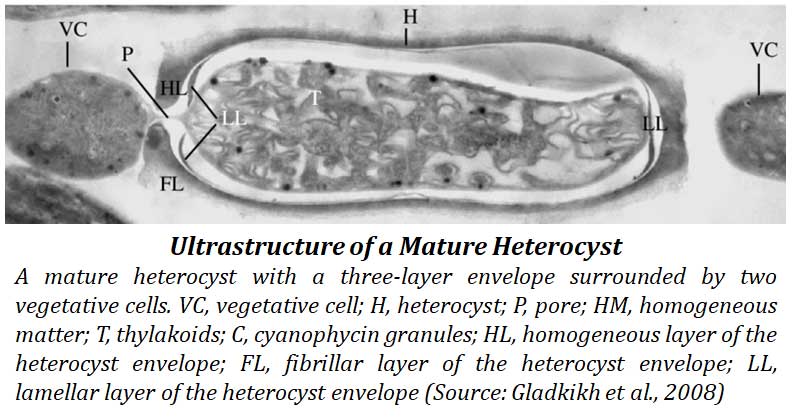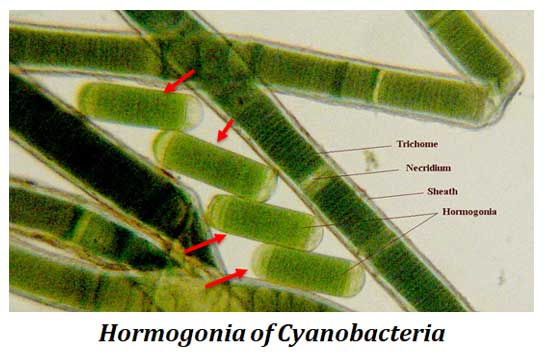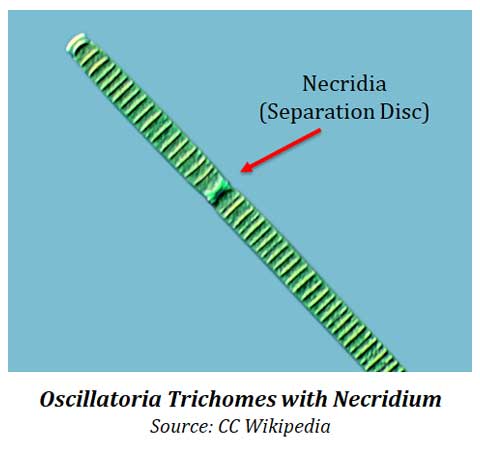General Characteristics of Cyanobacteria / Blue Green Algae (BGA)
Learning Objectives: What are Cyanobacteria or Blue Green Algae? What is Great Oxygenation Event? Cyanobacteria vs True Algae, What are Cyanotoxins? Thallus Diversity of Cyanobacteria, Cell Structure of Cyanobacteria, Reproduction in Cyanobacteria, Heterocyst and Hormogonia, Carbon Fixation by Blue Green Algae, What are Carboxysomes? Pigments in Cyanobacteria, Reserve Food of Cyanobacteria, Nitrogen Fixation by Cyanobacteria, Classification of Cyanobacteria and Characteristics of Cyanobacteria. (Also Check: Notes in Algae & Microbiology)
What are Cyanobacteria?
Ø Cyanobacteria are a group of Gram-negative bacteria (prokaryotes) that obtain energy via photosynthesis. They contain the pigments such as various chlorophylls, carotenoids and phycobilins.
Ø They are also known as Cyanophyta or Oxyphotobacteria or Cyanophyceae.
Ø Cyanobacteria are commonly called Blue-Green Algae (BGA).
Ø The name blue-green algae come from their blue-green clour and algae-like morphology.
Ø Modern botanists restrict the term algae to eukaryotes. Thus, cyanobacteria cannot be considered algae. However, they were treated as algae previously and placed in a separate group due to their prokaryotic nature.
Ø Cyanobacteria have similar morphology to algae – Thallus and Colony.
Ø They appear to have originated in a freshwater or terrestrial environments.
Ø The phototrophic eukaryotes perform photosynthesis in plastids.
Ø Plastids of plants have their ancestry in Cyanobacteria.
Ø Eukaryotes acquired the plastids long ago via endosymbiosis.
Ø The endosymbiotic Cyanobacteria in eukaryotes evolved and differentiated into specialized organelles such as Chloroplasts, Etioplasts and Leucoplasts.
| You may also like NOTES in... | ||
|---|---|---|
| BOTANY | BIOCHEMISTRY | MOL. BIOLOGY |
| ZOOLOGY | MICROBIOLOGY | BIOSTATISTICS |
| ECOLOGY | IMMUNOLOGY | BIOTECHNOLOGY |
| GENETICS | EMBRYOLOGY | PHYSIOLOGY |
| EVOLUTION | BIOPHYSICS | BIOINFORMATICS |
Ø Unlike heterotrophic prokaryotes, Cyanobacteria have internal membrane systems.
Ø The membrane system consists of flattened sacs called thylakoids.
Ø Photosynthesis is performed in the thylakoids.
Microbiologists consider BGA as Bacteria (Cyanobacteria)
Ø The algologist’s view of algae is that an organism with chlorophyll-a and not differentiated into roots, stem and leaves (thallus) are called algae.
Ø Cyanophyceae contain chlorophyll-a, and they are thalloid also.
Ø Thus, algologists treat BGA as a separate group of algae namely Myxophyceae.
Blue Green Algae differ from True Algae
Ø BGA are prokaryotic organizations whereas true algae are eukaryotic.
Ø The true nucleus is absent (incipient nucleus).
Ø Membrane-bound organelles are absent in BGA.
Ø Absence of nucleolus and nuclear membrane in BGA.
Ø The distribution of pigments is not in chloroplasts in Cyanobacteria.
Ø The cell wall is made of peptidoglycan, not cellulose.
Ø Ribosomes are 70S type.
Ø Genetic material is circular DNA (cccDNA). (Also Check Prokryotic vs Eukaryotic DNA)
Role of Cyanobacteria in Great Oxygenation Event
Ø Cyanobacteria were the earliest abundant photosynthetic organisms on the surface of the earth.
Ø They converted the early oxygen-poor, reducing atmosphere (less oxygen in the atmosphere) into an oxidizing one (more oxygen) by producing and releasing oxygen as a by-product of photosynthesis.
Ø Thus, the Cyanobacteria caused the Great Oxygenation Event (GOE). GOE changed the composition of the Earth’s life forms.
Ø GOE led to the near-extinction of anaerobic organisms thereby GOE forced the evolution of aerobic organisms.
What is Great Oxidation Event (GOE)?
Ø Also called the Great Oxygenation Event: A period when Earth’s atmosphere and shallow ocean first experienced a rise in oxygen level.
Ø The phenomenon occurred approximately 2.4–2.0 billion years ago (Paleoproterozoic era).
Ø Geological and isotopic evidence suggests that biologically produced molecular oxygen (dioxygen, O2) started to accumulate in Earth’s atmosphere.
Ø This changed the earth’s atmosphere from a weakly reducing atmosphere (practically no oxygen) into an oxidizing atmosphere (abundant oxygen). GOE caused the extinction of many existing species on Earth.
Ø The cyanobacteria producing the oxygen caused the GOE event, which enabled the subsequent development of multicellular life forms.
What are Cyanotoxins?
Ø Cyanobacteria produce a range of toxins known as cyanotoxins. Cyanotoxins can pose a danger to humans and animals.
Ø Examples of Cyanotoxins:
Ø Microcystins: Produced by Microcystis and Anabaena.
Ø Nodularins: Produced by Nodularia.
Ø Anatoxin-a: Produced by Anabaena.
Ø Cylindrospermosins: Produced by Cylindrospermopsis.
Ø Lyngbyatoxin-a: Produced by Lyngbya.
What is the Reserve Food material of Cyanobacteria?
Ø Cyanophycean starch: A special type of starch.
Ø Cyanophycean granules: Protein
Characteristics of Cyanobacteria
Ø Cyanobacteria are a group of photosynthetic bacteria (Prokaryotes).
Ø Some Cyanobacteria have nitrogen-fixing capacity.
Ø They live in a wide variety of moist soils and water.
Ø They can be free-living or in a symbiotic relationship with plants.
Ø Some Cyanobacteria are lichen-forming with fungi (as in the lichen genus Peltigera).
Ø Thallus range from unicellular to filamentous forms.
Ø Some are colonial forms and the colonies may form filaments, sheets, or even hollow spheres.Ø Some filamentous species can differentiate into several different cell types:
Ø Vegetative cells – The normal, photosynthetic cells that are formed under favorable growing conditions.
Ø Aakinetes: Climate-resistant spores that may form when environmental conditions become harsh.
Ø Heterocysts: Thick-walled cells which contain the enzyme nitrogenase. They are vital for nitrogen fixation in an anaerobic environment due to its sensitivity to oxygen.
Habitat of Cyanobacteria
Ø Cyanobacteria show a wide range of habitats, mostly they are aquatic forms.
Ø Most of them are fresh water and few are marine (Example: Trichodesmium). Trichodesmium erythraeum cause the red colour to the Red Sea.
Ø Some grow as endophytic symbionts (N2 fixation) in roots of Cycas, leaves of Azolla, and thallus of Anthoceros. Example: Nostoc and Anabaena.
Ø Few species can form symbiotic association in Lichen.
Ø Some can grow in unusual habitats such as hot springs.
Thallus Diversity/Forms of Cyanobacteria
Ø Unicellular forms: Example: Prochlorococcus.
Ø Colonial forms: Example Gloeocapsa.
Ø In colonial forms, the cells of the colony occur in a common gelatinous matrix.
Ø In Merismopedia cells divide in only one plain.
Ø In filamentous forms, the filaments are called trichomes: Example Oscillatoria.
Ø Trichome: The vegetative filament surrounded by a sheath is called the trichome.
Ø The filaments are usually un-branched and uniseriate.
Ø Some species show pseudo-branching as in Scytonema.
Cell Structure of Cyanobacteria
Ø The cell is with a distinct cell wall, covered by a mucilaginous sheath.
Ø The complete cell is filled with cytoplasm.
Ø The protoplasm is differentiated into two regions:
Ø Chromoplasm: Outer peripheral region which is pigmented.
Ø Centroplasm: Central region which is not pigmented.
Ø Pigments of Cyanobacteria: Phycocyanin, Phycoerythrin, Carotenes, Xanthophylls and Chlorophylls.
Ø Pigments are not found in chromatophores as in other algae.
Ø Oil droplets and glycogen granules are also found in the cytoplasm.
Ø Cell vacuoles are absent, Gas vacuoles may present.
Ø Membrane-bound organelles are also absent. Ribosomes are present, 70S type.
Ø Carboxysomes may present.
Nucleoplasm
Ø Central region of BGA which occupies the genetic material is called the nucleoplasm.
Ø The nucleoplasm can be called an incipient nucleus.
Ø The nucleoplasm contains most of the genetic materials.
Ø Genetic material is DNA which is freely distributed in the nucleoplasm along with RNA and proteins. DNA does not organize into chromosomes.
Ø In Cyanobacteria the DNA is not associated with histone proteins (Also check: Nucleosome Model of Chromosome)
Ø The DNA is covalently closed circular DNA (cccDNA).
Heterocysts (heterocytes)
Ø Heterocysts are specialized nitrogen-fixing cells in certain filamentous BGA.
Ø They are formed during nitrogen starvation by some filamentous Cyanobacteria Example: Nostoc, Cylindrospermum and Anabaena.
Ø They can fix nitrogen from dinitrogen (N2) in the air using the enzyme nitrogenase.
Ø The nitrogenase enzyme is inactivated by oxygen.
Ø Heterocyst creates a micro-anaerobic environment for the functioning of the nitrogenase enzyme to fix atmospheric nitrogen.
Learn more about Heterocysts
Reproduction in Cyanobacteria
Ø Sexual reproduction is completely absent in Cyanobacteria.
Ø Reproduction takes place by vegetative and asexual methods.
Ø Sex organs, gametes and flagellated zoospores are completely absent.
Ø Vegetative reproduction occurs by cell division, fragmentation and hormogonia formation.
Ø Asexual reproduction is facilitated through akinetes, endospores, exospores and heterocysts.
Ø Endospores: Cytoplasm divide into several bits and these bits develop into spores; each spore can germinate into a new plant (Eg. Dermocapsa)
Also Check: Bacterial Endospores
Ø If endospores are very small and large in number, they are called nano-spores.
Ø Exospores: Spores produced outside the cell by constrictions (Eg. Chamaesiphon).
Hormogonia
Ø Hormogonia are the motile filaments of cells produced by some Cyanobacteria.
Ø Hormogonia can travel away from the main biomass and form new colonies.
Ø Cells in a hormogonium are often thinner than in its vegetative state.
Ø Cells on either end of the motile chain may be tapered.
Ø To break away from the parent colony, a hormogonium often must tear apart a weaker cell in a filament, called a necridium.
Ø Each cell of the hormogonia will have a gelatinous cell wall.
Ø The hormogonia lack flagella, however, hormogonia can move about by gliding along surfaces.
Movement in Cyanobacteria
Ø Many of the multicellular filamentous forms are capable of a waving motion (Eg. Oscillatoria).
Ø Waving movement: filament oscillates back and forth to achieve the movement.
Ø In water columns, some cyanobacteria float by forming gas vesicles.
Ø These vesicles are not organelles as such.
Ø Gas vesicles are not bounded by lipid membranes but by a protein sheath.
Carbon Fixation in Cyanobacteria
Ø Cyanobacteria use the energy of sunlight to drive photosynthesis.
Ø Since they are aquatic organisms, they employ several strategies which are collectively known as a “CO2 Concentrating Mechanism” to aid in the acquisition of inorganic carbon (CO2).
Ø The best strategy adopted is the widespread prevalence of Bacterial Microcompartments (BMC) known as carboxysomes.
Ø It is believed that carboxysomes tether the CO2-fixing enzyme, RuBisCO, to the interior of the shell, as well as the enzyme carbonic anhydrase, using metabolic channelling to enhance the local CO2 concentrations and thus increase the efficiency of the RuBisCO enzyme.
Also Check: Carboxysomes
Nitrogen Fixation by Cyanobacteria
Ø Some Cyanobacteria can fix atmospheric nitrogen in anaerobic conditions by using specialized cells called heterocysts.
Ø Heterocysts may also form under the appropriate environmental conditions (anoxic) when fixed nitrogen is scarce.
Ø Heterocyst-forming species are specialized for nitrogen fixation and can fix nitrogen gas into ammonia (NH3), nitrites (NO−2) or nitrates (NO−3).
Ø Atmospheric nitrogen is not bioavailable to plants, except for those having endosymbiotic nitrogen-fixing bacteria, especially the family Fabaceae.
Ø Free-living cyanobacteria are present in the water of rice paddies, and cyanobacteria can be found growing as epiphytes on the surfaces of the green alga, Chara, where they may fix nitrogen. Cyanobacteria such as Anabaena (a symbiont of the aquatic fern Azolla) can provide rice plantations with biofertilizer.
| You may also like... | ||
|---|---|---|
| NOTES | QUESTION BANK | COMPETITIVE EXAMS. |
| PPTs | UNIVERSITY EXAMS | DIFFERENCE BETWEEN.. |
| MCQs | PLUS ONE BIOLOGY | NEWS & JOBS |
| MOCK TESTS | PLUS TWO BIOLOGY | PRACTICAL |
Classification of Cyanophyceae by Fritsch – 5 Orders
(1) Chlorococcales: Unicellular or colonial forms but never a filamentous body. Reproduction is by vegetative cell division. Endospore production is not reported. (Example: Anacystis, Gloecapsa, Chroococcus).
(2) Chamaesiphonales: It also consists of unicellular or colonial forms. Reproduction is by endospore formation (Example Chamaesiphon).
(3) Pleurocapsales: The plant body is filamentous without the formation of hormogonia (Example: Pleurocapsa).
(4) Nostocales: Filamentous unbranched plant body with the formation of hormogonia. (Example: Spirulina, Oscillatoria Lyngbya, Nostoc, Anabaena).
(5) Stigonematales: The plant body is filamentous and branched with the formation of hormogonia (Example: Stigonema).
<<< Back to Microbiology Notes Home Page…
If you Like this Post, I Would Like to Hear it from You… Please COMMENT . . . . (below ↓)
Also Check…
@. General Characteristics of Algae
More Lecture Notes from Easy Biology Class…
Botany|Zoology|Biochemistry|Genetics|Cell & Molecular Biology|Biotechnology|Physiology & Endocrinology|Plant Physiology|Microbiology|Immunology|Embryology|Ecology|Evolution|Biophysics|Research Methodology|Biostatistics|Chemistry for Biologists|Physics for Biologists

